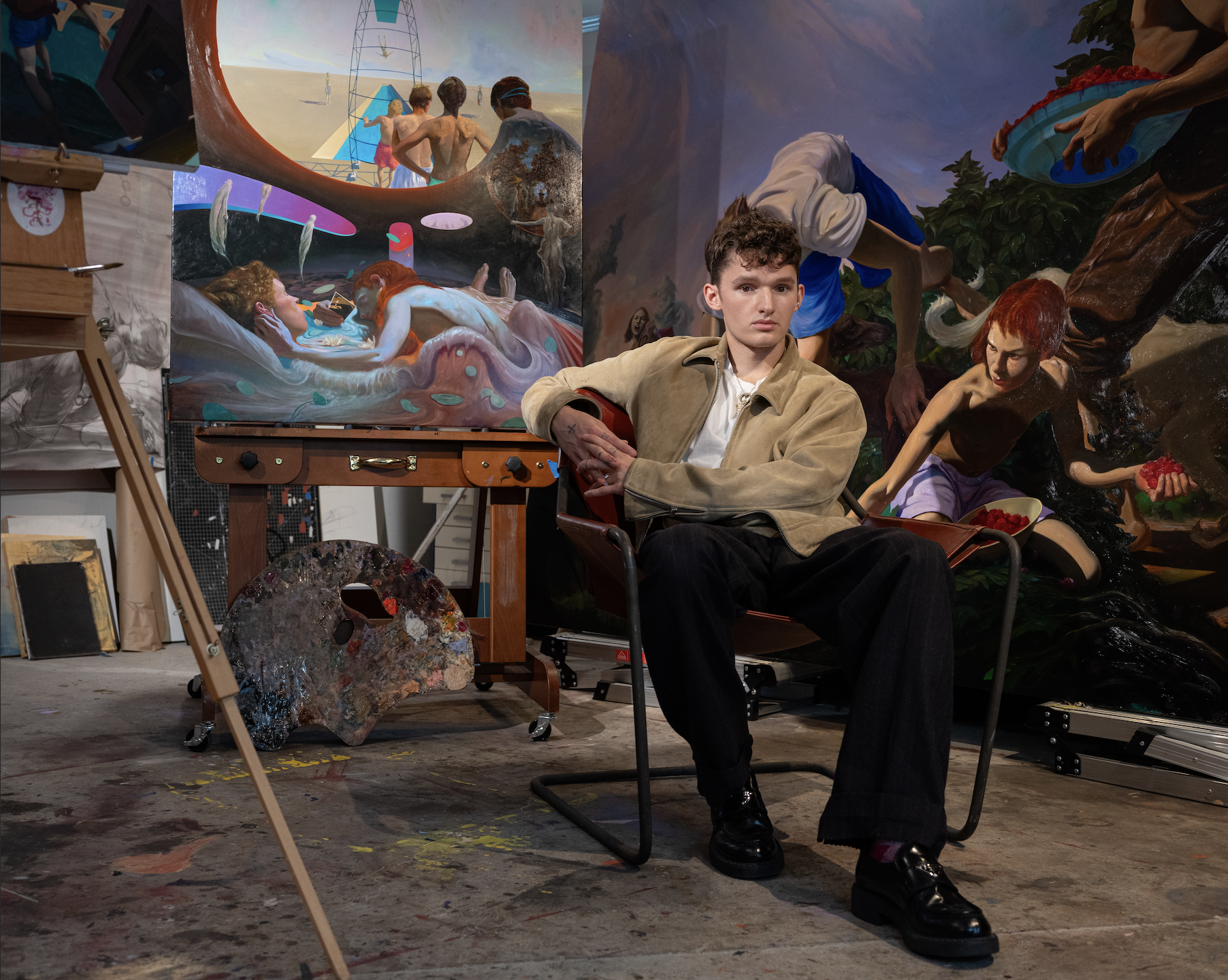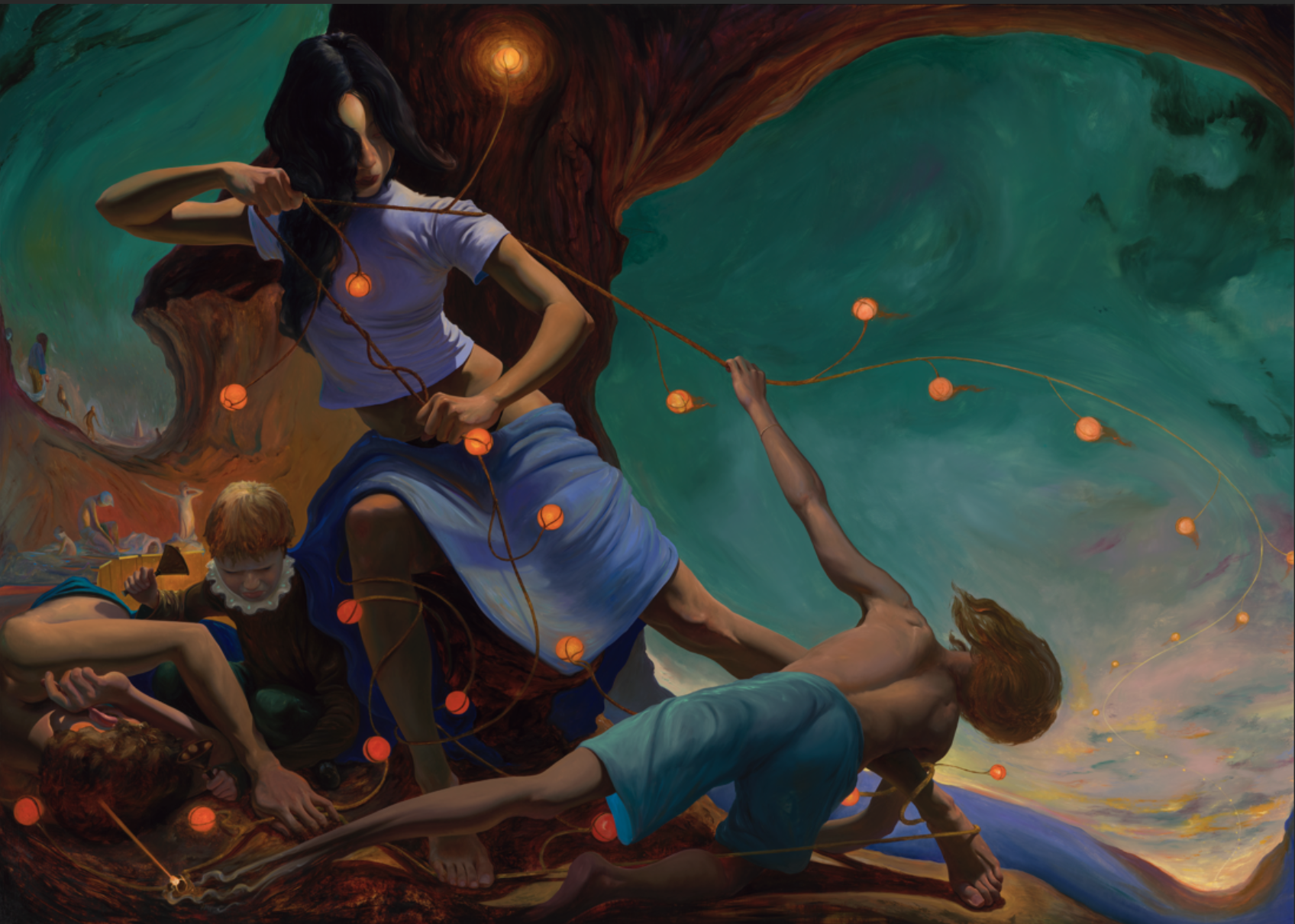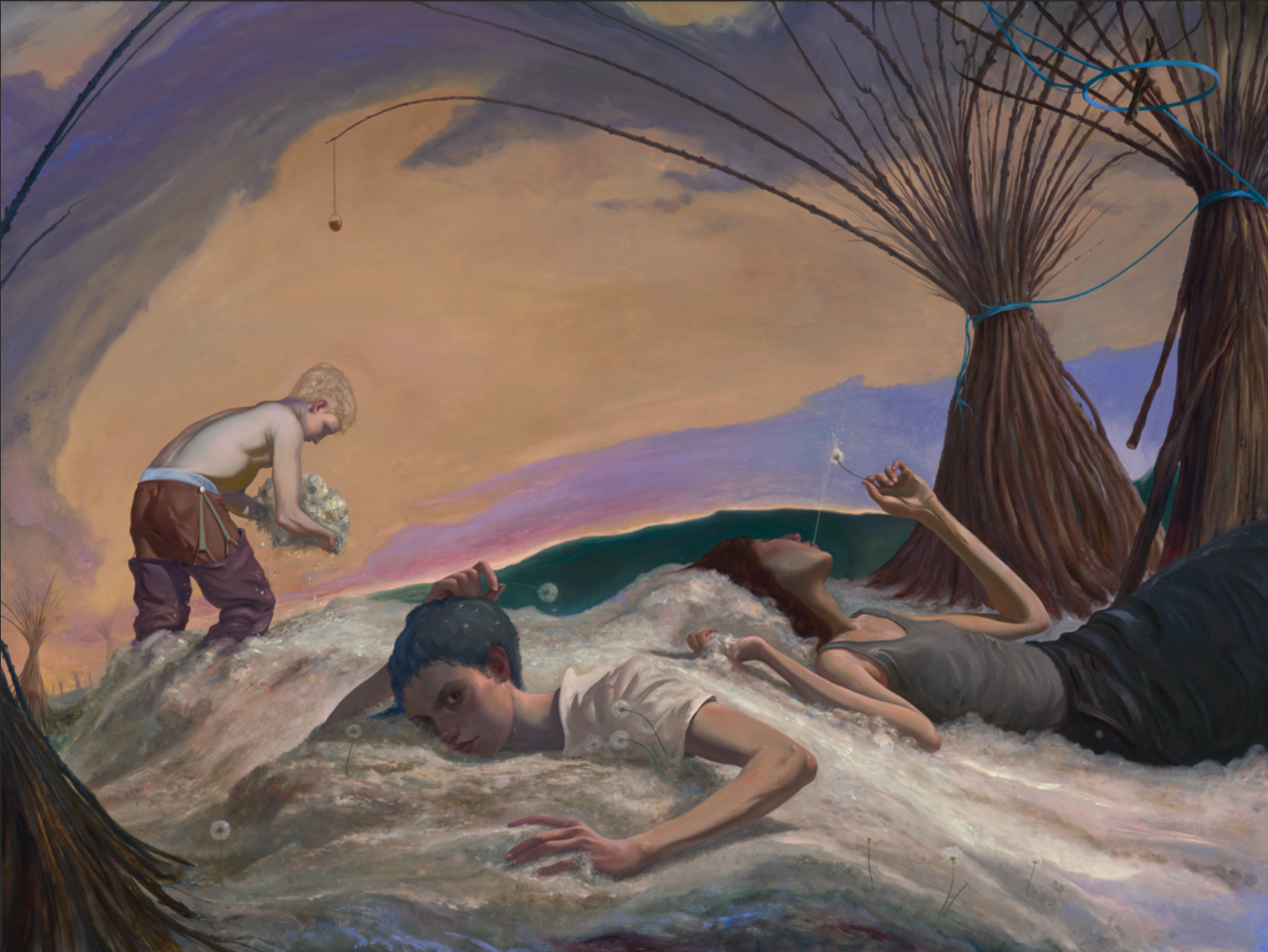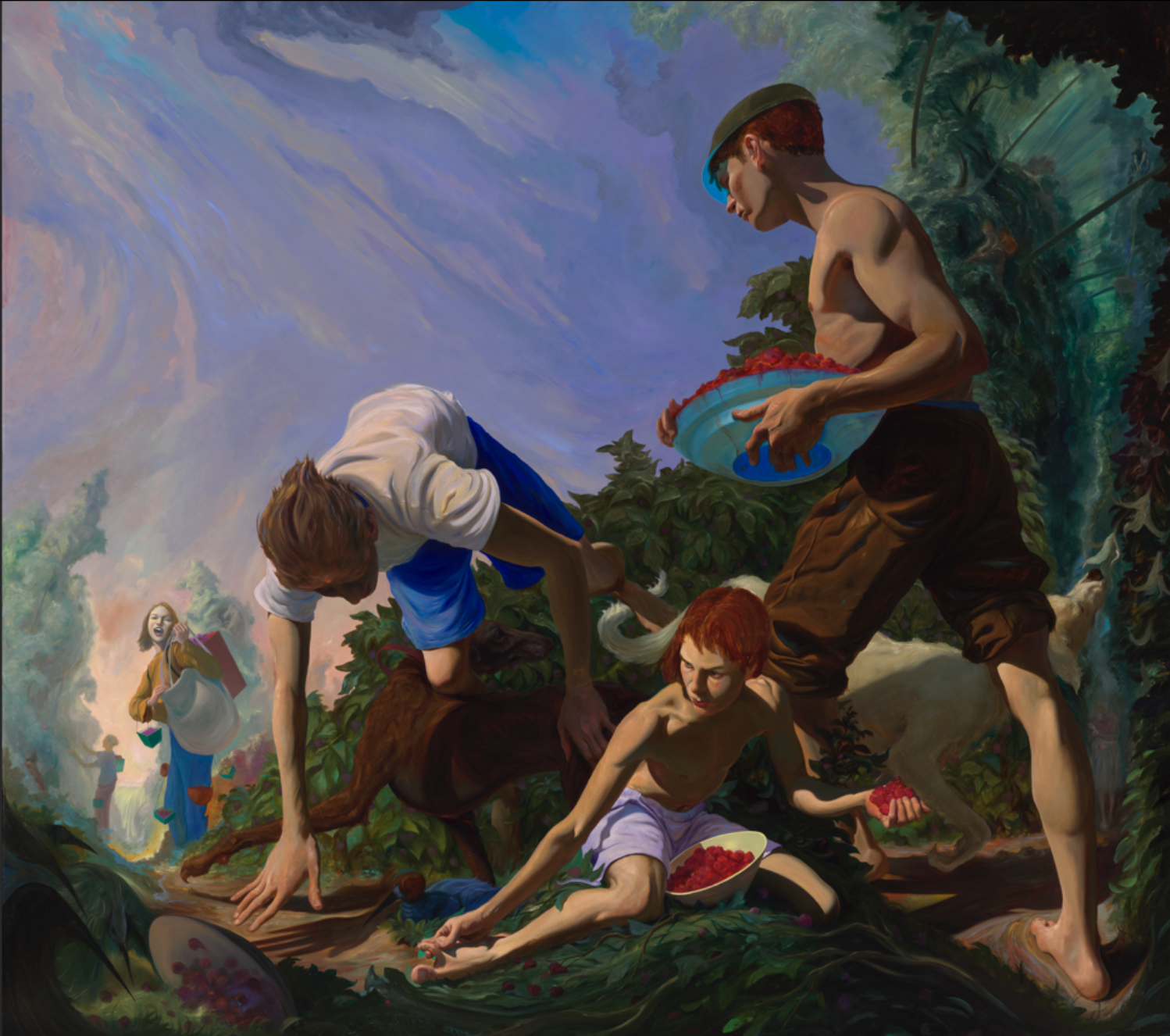Whitehot Magazine
November 2025
"The Best Art In The World"
"The Best Art In The World"
November 2025
Leo Frontini has quickly established himself as a painter to watch
 LA based painter Leo Frontini, image courtesy the artist. Photo: Sophie Dezhao Jin
LA based painter Leo Frontini, image courtesy the artist. Photo: Sophie Dezhao Jin
By NOAH BECKER October 22nd, 2025
Everlapsing Interlude, is painter Leo Frontini’s latest solo exhibition, opening October 25th, 2025 at Make Room in Los Angeles. At just 25 years old, Frontini has quickly established himself as a painter to watch, with recent solo shows at Albertz Benda (NYC and LA) and 1969 Gallery (NYC).
Leo Frontini captures my imagination. As a figurative oil painter myself, I can see all the stylistic references in the work. We had a chance to converse via email and I hope you enjoy his paintings and the conversation that follows.
Everlapsing Interlude explores the tension between endings and beginnings. What first drew you to this concept, and how does it manifest visually in your work?
With every show, I start with a broad theme. For this one, it was time. As I began working on the show, it became about progressions or cycles in time, and then narrowed to “Beginnings and Endings,” as my work has an allegorical sensitivity. This led to the title. As I thought about narratives, the classic “Ever lasting/ Ever-after” became “Everlapsing.” As the work progressed, I felt the paintings began to carry themes and symbols of moments in between, of pause or causality. It was the paintings, Anamnesis and Wishes, that brought to mind “Interlude.” Being about remembering or the search for a memory, is visualized in the painting as the figure looks at a photo, and his memory rises above him in the scene. An attempt to visualize the search for a memory and the many pockets that open as the mind wanders. Wishes, being more literal, as the figures lie on a bed of dandelions. A figure in the middle ground carries them away, framed by bound trees that symbolize constriction. I feel remembering, wishing, and daydreaming are moments we often overlook, despite their significance to our growth and narrative self. I think these moments are significant as they lead to and inform our actions.
 The Horizon Lines Rise, oil on canvas, 84 x 60 inches
The Horizon Lines Rise, oil on canvas, 84 x 60 inches
You’ve described your paintings as “liquid narratives.” How do you approach storytelling in a medium that’s inherently still?
There is often a theme on the surface, but once uncovered, I feel the paintings can take on many meanings and interpretations. An ambiguity arises unconsciously when composing the drawings and throughout the painting process. This is where emotions come through in the paint and is visualized in how I decide to paint something. The background I often don't plan, and that can really inform the narrative based on my energy when painting it. Additionally, I like to explore perspective and distortion when composing, which can lead to a more dreamlike fluid narrative as if it's shifting or ephemeral in its chaos.
Your process is deeply technical—from layered gesso to handmade oil mediums. How does that material rigor influence the emotional or conceptual tone of your paintings?
The paint application always informs the emotion of the painting. How the marks are made gives a sense of the artist's present energy when it was applied, whether it was today or centuries ago. Also, it gives the painting a lively sense that goes beyond what is represented. Whenever I look at a painting, I am often drawn to its physicality before its composition or representation. I like smooth, refined areas, areas of deliberate impasto, and marks that carry expression. I like to work on a smooth canvas surface, as it allows me to create texture with intention and explore the contrast that makes a painting's surface so dynamic. Within my practice, having control over the medium allows me to push the painting's emotional energy further, informing the scene and its perception.
 Wishes, oil on canvas 48 x 36 inches
Wishes, oil on canvas 48 x 36 inches
You draw from Rococo, Rubens, Breugel, Monet, Vuillard, Bonnard, and Byzantine art. How do you reconcile those art historical influences with your distinctly contemporary voice?
I feel my list of influences is endless. I look to great painters of the past mostly for technical reasons. Painting the figure is very complex in addition to everything else that makes up a representational painting. With this research of the past, my paintings, informed by the present, offer an interesting dialogue across time. I also love the stylization throughout each period and between artists; I find the differences between them so interesting, as they reflect the individual and their influences. The most significant way the influences come through is in the craft or execution of the surface and in my approach to my art practice as a deep passion. Connecting with the past has given me the ability to execute my paintings in a way that is informed and constantly evolving in the present.
Many of your compositions seem to oscillate between chaos and order, or dissolution and form. How do you know when a painting has reached its equilibrium?
My process has developed to the point where I can understand when it will be finished. Painting is often a process of bringing order to chaos. The chaos and order of my paintings are intentional, derived from the early stages of the drawing. I know which areas will be more delicately organized or focal points and which will melt away into a more painterly abstraction. However, I still try to organize the loose areas of the painting. So it's all quite intentional, and in my process, it always leads towards a conclusion so that the next painting can begin.
 Of Bountiful Folly, oil on canvas, 96 x 84
Of Bountiful Folly, oil on canvas, 96 x 84
In "Of Bountiful Folly", you merge a childhood memory with the visual language of Socialist Realism. How does personal experience interact with broader cultural or historical references in your work?
I find there are many things that we experience universally; these are themes I often reflect on in my work, as I hope people can connect to the narratives. Of Bountiful Folly, informed by Millet’s The Sower, is a play on the draining folly of the present and overproduction reflected in the infinite raspberry bush that frames the right side of the composition. Similar to the contradictions found throughout our society and cultures, Of Bountiful Folly is a paradoxical scene of foolish abundance. As the life around me informs my paintings, I see the conceptual components come into play as I compose. It morphs into something beyond a memory of picking raspberries, maybe to something darker.
Your paintings often blur the line between figure and environment. Do you see your figures as protagonists within a scene, or as extensions of the worlds they inhabit?
I see the figures more as actors. They present the scene or carry out the action that informs the metaphor or symbolism represented. However, the figures sometimes give the painting a new meaning that was not initially intended. They are more extensions of the scene, as the environments usually provide more of the narrative. I enjoy the process of creating these spaces they inhabit.
At only 25, you’ve already had multiple solo shows. How do you navigate growth and experimentation while the art world’s attention continues to accelerate around you?
I really enjoy the work. Through constant work, the practice naturally evolves. I like to switch up my approach as well by adding new stages to the process or exploring new mediums. Also, I still study as much as possible, including drawing and painting from life and studying nature. This is always humbling and brings me back to the roots of my art practice. With tight timelines between shows, I still make time for experimentation, and I have found it refreshing. I also like to explore new media, such as etchings and sculpture. These force you to think differently, but they also all inform each other and lead towards growth. It is important to me to keep learning and exploring through each piece. WM

Noah Becker
Noah Becker is an artist and the publisher and founding editor of Whitehot Magazine. He shows his paintings internationally at museums and galleries. Becker also plays jazz saxophone. Becker's writing has appeared in The Guardian, VICE, Garage, Art in America, Interview Magazine, Canadian Art and the Huffington Post. He has written texts for major artist monographs published by Rizzoli and Hatje Cantz. Becker directed the New York art documentary New York is Now (2010). Becker's new album of original music "Mode For Noah" was released in 2023.
Becker's 386 page hardcover book "20 Years of Noah Becker's Whitehot Magazine of Contemporary Art" drops Aug 8, 2025 globally on Anthem Press.
Noah Becker on Instagram / Noah Becker Paintings / Noah Becker Music / Email: noah@whitehotmagazine.com
view all articles from this author







